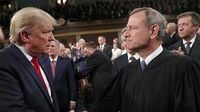The U.S. Supreme Court returned to the bench on Monday, October 6, 2025, launching what promises to be one of its most consequential terms in years. The justices face a docket brimming with high-stakes cases that will test the boundaries of presidential power, reshape the nation's approach to voting rights and gender identity, and potentially overturn decades-old legal precedents. At the center of many of these disputes sits President Donald Trump, whose aggressive use of executive authority has sparked both celebration and alarm across the political spectrum.
The new term opened after a three-month recess, with the nine justices convening to reset their docket and weigh appeals that had piled up over the summer. As reported by ABC News and Fox News, the court's agenda is dominated by a series of disputes over Trump-era policies—many of which have already produced a string of interim victories for the administration. These cases, however, now move beyond temporary orders and into final, far-reaching decisions that could reverberate through the 2026 midterm elections and the very structure of American government.
One of the term’s marquee cases will decide whether President Trump’s sweeping global reciprocal tariffs, imposed under emergency authority, represent an illegal expansion of executive power. The court will also determine whether the tens of billions of dollars collected from these tariffs must be refunded. Hofstra Law professor James Sample described the case as “a staggeringly important case from an economic perspective and from a separation of powers perspective,” noting, “If you think of a tariff as a tax, this is one of the biggest tax hikes in American history, and it didn’t go through Congress at all.”
Oral arguments on the tariffs are scheduled for November, according to Fox News. The court’s decision will set a precedent not only for Trump but for future presidents considering similar moves. As Thomas Dupree, a prominent appellate attorney, put it, “A big fraction of the Supreme Court's docket will present the question: ‘can President Trump do?’— then fill in the blank. And that could be imposing tariffs; firing independent board members; removing illegal aliens; sending the military into cities like Los Angeles.”
Another major test involves Trump’s firing of Democratic members of independent federal agencies without cause—a move that challenges 90 years of legal precedent. The court will also consider Trump’s attempt to remove Federal Reserve Board Governor Lisa Cook over unproven allegations of mortgage fraud. These cases, as Sample noted, raise “monumental” questions about whether presidents can shape independent agencies and the Federal Reserve “at his or her whim.” The court is expected to issue decisions on these matters by early 2026.
At the heart of the term is also the constitutionality of Trump’s executive order to end birthright citizenship by fiat, a move that would upend more than a century of established law under the 14th Amendment. Jeffrey Rosen, president and CEO of the National Constitution Center, observed, “There’s a broad view that birthright citizenship is the most likely place the court will place limits on Trump.”
But the Supreme Court’s influence this term extends well beyond the presidency. The justices will hear a Louisiana case challenging the creation of majority-black congressional districts and the use of race in redistricting—directly confronting Section 2 of the Voting Rights Act. George Washington University law professor Spencer Overton warned that if the court accepts the arguments to outlaw race-based considerations, “it could effectively dismantle Section 2” and allow legislatures in states like Louisiana, Georgia, Alabama, Mississippi, and Texas to “dismantle districts where black and Latino voters have an opportunity to elect candidates of their choice.”
In the culture wars, the court is set to review a Colorado law banning conversion therapy for minors, with a Christian therapist arguing that the ban violates her free speech rights. Twenty-seven states have similar laws, all intended to protect LGBTQ youth from what they describe as harmful practices. Georgetown Law professor Stephanie Barclay explained, “If it's a client who's suffering from gender dysphoria and doesn't want to feel that way, and said, 'I would like to feel comfortable in the body I was born in, can you help me?' That's the type of talk therapy that Ms. Chiles wants to offer.”
Meanwhile, two cases from West Virginia and Idaho will force the justices to weigh in for the first time on state restrictions barring transgender girls from participating in girls’ school sports. Plaintiffs argue these laws violate Title IX and the Equal Protection Clause of the 14th Amendment, while the states insist they are necessary for fairness and safety. Josh Block of the ACLU LGBTQ and HIV Project stated, “We are going to be looking in these cases not just at the impact on transgender girls and women who are really being excluded from an educational program, we're also going to be looking to whether the case is used to issue a broader ruling against transgender folks more generally.”
Underlying these legal battles is a court grappling with its own reputation and the principle of stare decisis—respect for established precedent. While the conservative majority has overturned fewer precedents than previous post-war courts, the significance and speed of their decisions have drawn scrutiny. William & Mary Law School professor Jonathan Adler told ABC News, “They seem to all be pushing in one direction, but in terms of the volume or the number, it's actually less.” Yet, as Benjamin Mizer, former Acting Associate U.S. Attorney General, noted, “What matters is not just what they're overturning, but how they're doing it. I think that they are showing an eagerness to do so.”
Justice Ketanji Brown Jackson has been outspoken about the court’s recent tendency to accommodate the Trump administration. After a late August order allowing the government to terminate nearly $800 million in health research grants, she wrote in dissent, “Right when the Judiciary should be hunkering down to do all it can to preserve the law's constraints, the Court opts instead to make vindicating the rule of law and preventing manifestly injurious Government action as difficult as possible. This is Calvinball jurisprudence with a twist. Calvinball has only one rule: There are no fixed rules. We seem to have two: that one, and this Administration always wins.”
Yet, other justices have pushed back against the perception of partisanship. Justice Brett Kavanaugh recently emphasized the importance of separation of powers, saying, “No one person or group of people should have too much power in our system.” Justice Amy Coney Barrett, promoting her new book, told Fox News, “We don't wear red and blue, we all wear black because judges are nonpartisan ... We're all trying to get it right. We're not playing for a team.”
Chief Justice John Roberts, who marks his 20th anniversary on the bench this term, faces perhaps the greatest challenge of his tenure: steering the court through a period of deep ideological division and public skepticism. According to a Fox News poll, 47% of voters approve of the court’s performance, up from a record low last year, but more than twice as many believe the court is “too conservative” rather than “too liberal.”
As the justices begin oral arguments and prepare to issue rulings that will shape the nation’s legal and political landscape for years to come, all eyes remain fixed on the Supreme Court. With the stakes so high and the issues so contentious, the coming months are sure to test the limits of the law—and the court itself—in ways unseen in a generation.






